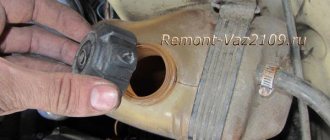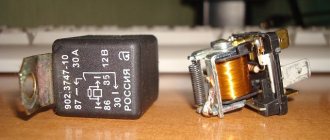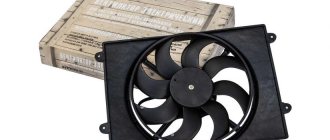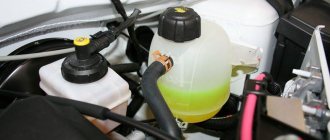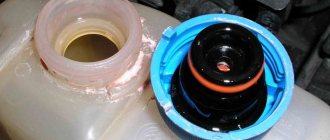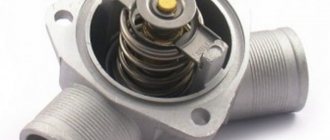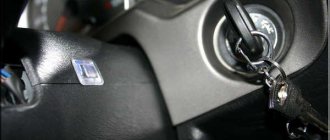The engine cooling system is an important structural element of a car. Its malfunction leads to poor heating of the engine to the required temperature, which causes poor operation of the stove, loss of power and reduced service life of the power unit. On the other hand, the engine system may overheat, which causes breakdown of the cylinder-piston group.
cooling system vaz 21099 carburetor diagram
VAZ 2199 cooling system injector
1 – element in the form of a plug for the expansion tank; 2 – expansion tank; 3 – hose for draining liquid from the pipe; 4 – hose passing between the radiator and the expansion tank; 5 – hose leading from the radiator; 6 – tank to the left of the radiator; 7 – aluminum tube; 8 – plug systems; 9 – tank to the right of the radiator; 10 – drain plug; 11 – middle of the radiator; 12 – casing for electric fan; 13 – plastic wings of the electric fan; 14 – electric motor; 15 – toothed pump pulley; 16 – pump impeller; 17 – camshaft drive belt; 18 – engine block; 19 – pump pipe; 20 – radiator hose with supply function; 21 – heater radiator hose with drain function; 22 – hose supplying coolant to the throttle pipe; 23 – exhaust pipe; 24 – hose for refilling; 25 – heater radiator hose with supply function; 26 – thermostat; 27 – coolant temperature sensor; 28 – coolant level indicator sensor.
The cooling system of VAZ 21093,2109,21099 removes heat from engine parts subject to heating through forced circulation. And the injector doses the flow of fuel. Structurally, the VAZ injector cooling system consists of:
- coolant pump,
- monoblock thermostat,
- electric radiator fan,
- radiator with expansion tank,
- pipelines, pipes, drain plugs.
Cooling system features
The car engine cooling system is designed by designers to perform several vital functions. But, in some cases, especially on high-mileage vehicles, this system is a weak point.
There are three main types of cooler:
- Water.
- Antifreeze.
- Antifreeze.
The first is practically no longer used, as it boils away quickly, causes damage to metal parts of the engine and is dangerous when used in the cold season. The second is the most common and inexpensive. It is produced from inorganic compounds, which creates an oil film on the engine walls, which significantly reduces thermal conductivity.
If problems constantly arise in the cooling system, it is most practical to use antifreeze, since it is more financially profitable
Owners of VAZ 2109, 2108 and VAZ 21099 cars, no matter whether carburetor or injection, are more likely than others to encounter this problem. The most common breakdowns are:
- Radiator leak.
- Cooler tank failure.
- Pump malfunction.
- Damage to the interior heater radiator.
- Coolant slagging.
When parts need to be replaced
When is it necessary to replace the VAZ 2109 coolant and cooling system elements? The fluid must be changed regularly after a certain period of use. Parts are not changed periodically, but only after a breakdown. One of the causes of breakdowns is overheating due to a malfunction of some element in the cooling system. The following signs of engine overheating can be observed:
- the coolant temperature is higher than normal and can exceed 120ºС, this is indicated by a special sensor;
- there is a sharp drop in engine power;
- the sound of the engine changes, a ringing metallic knock appears;
- oil consumption increases;
- Coolant consumption increases significantly.
As a result of overheating, after you open the hood, you will see deformed parts - bent cylinder head, gasket edging, burnout of some parts. Repairing deformed parts does not make sense; they need to be replaced.
The procedure for replacing coolant on a VAZ 2109-2108
So, the first thing you need to do is unscrew the cap in the expansion tank to relieve pressure in the system - this will allow antifreeze or antifreeze to drain faster:
Then we put a thin hose on the outlet of the radiator tap, which is located in the lower right corner and turn off the tap:
And at the same time, lower the end of the hose into the drain container. Personally I did it like this:
At the same time, you can immediately unscrew the plug in the engine block with a key number 13:
And substituting another container, we wait until all the coolant drains from the block and the cooling radiator:
If antifreeze or antifreeze flows out of the system and is very dirty, has traces of rust and other particles, then it is necessary to flush the cooling system several times, pouring ordinary water into it and draining it back. This procedure must be repeated until the water comes out clean!
Then you can screw the block plug back in:
Also close the radiator tap and you can start pouring new antifreeze into the VAZ 2109-2108 system.
This must be done in a thin stream without sudden movements, so as not to form an air lock. Otherwise, you will have to drive it out later by opening the cap of the expansion tank and, with the “face” raised, heavily revving the engine on a warm engine.
After the new coolant is poured into the system up to the mark in the MAX expander, tighten the tank cap and start the engine. Let it run until the radiator cooling fan comes on. Then you can turn off the engine and, after a long stay, check the fluid level in the tank again. If it drops below the MAX mark, you need to top it up to the required level!
I don’t know why, but even many experienced owners drive their cars for more than 100,000 kilometers and never replace antifreeze or antifreeze during this period (depending on what is filled). In fact, this fluid needs to be changed every 2 years or the car's mileage of 45,000 km, whichever comes first.
If you do not change the coolant in a timely manner, then corrosion may appear in the channels of the block and cylinder head ahead of time and the engine life, of course, will be reduced. This is especially true for the cylinder head. Quite often I had to disassemble engines and look at the cooling channels in the cylinder head eaten by corrosion. After such a picture, you become scared for your car and you will definitely not forget to change the antifreeze on time.
So, below I will provide a more detailed report on the completion of this work, and also provide a list of the necessary tools:
- Head for 10 and 13
- Ratchet
- Phillips screwdriver
- Keys for 13 and 17 (provided that you have a 2111 engine and will have to remove the ignition module)
I’ve already said it above, but it’s better to repeat it again. If you have a 2110-2112 engine, then the antifreeze drain plug located in the block is free and can be used without any problems. If the engine model is 2111, then an ignition module is installed there, so it will have to be removed first. Here is its location (below the 4th cylinder):
After it is removed and set aside to avoid flooding with antifreeze, you can begin further work. We unscrew the front part of the engine crankcase protection so that you can place a container under the radiator drain hole.
Now we unscrew the cap of the expansion tank, then the plug in the engine block and radiator, of course, you first need to place a container of the required volume under each drain hole.
Here is the plug in the block after unscrewing:
And here on the radiator:
It is worth noting that when draining coolant on a VAZ 2110-2112, the car must be on a flat, flat surface. After all the antifreeze has drained, you can screw the plug into place in the cylinder block and radiator. Next, you can begin replacing the coolant. To avoid an air lock in the cooling system, first disconnect the fluid supply hose to the throttle assembly, which is shown in the photo below:
And when pouring antifreeze into the expansion tank, you need to pour it until it flows out of this disconnected hose. Then we put it on the terminal and tighten the clamp. Next, top up to the required level and tighten the tank cap.
We start the engine and let it warm up until the radiator cooling fan comes on. We wait until the car has completely cooled down (the morning after the replacement) and look at the fluid level in the conservator.
If it is below normal, then you need to add the required amount.
Sources
- https://www.avtorem.info/sovety/tosol-ili-antifriz—delaem-pravilny-vybor.html
- https://remont-vaz2109.ru/zamena-oxlazhdayushhej-zhidkosti-instrukciya/
- https://zarulemvaz.ru/zamena-oxlazhdayushhej-zhidkosti-na-vaz-2110-2112/
Driver actions
Having noticed that antifreeze begins to boil in the expansion tank, you need to take a number of mandatory measures. Don't wait for the coolant to start splashing out onto the hot engine. Once the liquid boils, there are corresponding reasons.
Pour antifreeze into the car
You already know at what temperature antifreeze usually boils in cars, what causes overheating and what consequences this can lead to. Therefore, no one wants to encounter something like this in their own car. It is necessary to start cooling the engine using available methods, not forgetting that the coolant is now under high pressure.
There are several useful tips and a certain algorithm of actions that allows even a beginner to figure out what to do if antifreeze suddenly boils.
- Be sure to try to quickly unload the engine. To do this, you can put the gearbox in neutral and drive until it comes to a complete stop.
- Turn on the fan and stove at the same time. Even if it’s hot outside, the heater will take away some of the heat, thereby speeding up the process of the engine temperature dropping.
- After stopping the car, turn off the engine. At the same time, leave the stove in working condition.
- Pull the handle or press the button to open the hood from the passenger compartment and access the engine compartment. There is no need to stand in front of the hood and open it, as hot steam will immediately come out.
- By opening the hood slightly, steam will come out and fresh air will begin to flow into the engine. Wait a while. Then lift the hood and lock it. It is better to have gloves or a rag with you so as not to grab possibly hot elements with your bare hands.
- Do not try to open the expansion tank cap immediately. Otherwise, you risk your own health. Liquid under pressure, even if the lid is opened slightly, can splash out and get on your skin.
- Wait about 30 minutes. At this time, you can try to find a driver who will take you to the service station, or call a towing service.
- When the engine has cooled down a little, open the expansion tank cap. Surely the coolant has become much less than the proper level. Add liquid into the reservoir in small portions. At the same time, the stove is still working.
- There is no need to immediately pour in a large volume of antifreeze if its level becomes minimal after boiling. Abrupt mixing of cold antifreeze or antifreeze with hot coolant can provoke dangerous negative consequences.
- If you can only get to the service station on your own, after adding coolant and cooling the engine, start it and set off on the road, trying not to load the engine. When the temperature again reaches above 100 degrees, stop, turn off the engine and wait for it to cool down again.
You can't sit and do nothing either. If the coolant continues the boiling process, the engine will overheat first to medium and then to high levels. You already know about the consequences of such heating.
Based on everything discussed above, we can speak with confidence about the seriousness of the problem of coolant boiling. To prevent such situations, carefully monitor the condition of the cooling system, check the functionality of the main components and try to carry out timely maintenance.
Sources
- https://luxvaz.ru/vaz-2109/322-sistema-ohlazhdeniya-2.html
- https://expertVAZ.ru/2109/sistema-ohlazhdeniya-kak-rabotaet.html
- https://ladafakt.ru/sistema-ohlazhdeniya-vaz-2109-inzhektor.html
- https://vaz-remzona.ru/sxema-oxlazhdeniya-vaz-2109/
- https://ladamaster.com/sistema-okhlazhdeniya-vaz-2109-inzhektor
- https://7road.ru/drugoe/net-cirkulyacii-v-sisteme-ohlazhdeniya-2.html
- https://www.vazzz.ru/vaz-2109-tsirkulyatsiya-ohlazhdayushhej-zhidkosti/
- https://avtomechanic.ru/vaz-2109/dvigatel-vaz-2109/konstruktsiya-sistemy-okhlazhdeniya-vaz-2109
Replacing coolant on VAZ 2108, VAZ 2109, VAZ 21099
Welcome! Coolant - it is needed only for the cooling system and in other systems of the car it is not used anywhere else, thanks to it the engine is cooled during operation and thus the engine takes longer to boil (If the system is working properly, it practically does not boil at all), if the liquid is removed from system, it will work, but it will boil so quickly (in about 5-10 minutes) that you will have to constantly turn off the engine of the car and wait until it cools down at least a little, besides, you will not be able to find out the temperature of the engine without liquid , because the sensor that monitors the temperature usually reads the temperature not of the engine (It’s just that everyone is already accustomed to calling it that, although the temperature of the liquid and the engine may even differ) but of the coolant itself, and how will it determine the temperature if this liquid is not there, therefore For the future, under no circumstances should you drive a car if all the fluid suddenly leaks out, since you won’t drive far and will most likely ruin the car’s engine.
Note! To replace this fluid in a car, you will need: An empty container of at least 10 liters (Although you can take less, it is best to stock up on a 10 liter container to avoid spilling the liquid), as well as wrenches, and a clean rag to use. wipe your hands and if liquid gets on the car engine, wipe it off it; in addition, you may need hex keys and different types of screwdrivers!
When should you change the coolant? If you follow the manufacturer’s advice (we don’t recommend doing as the manufacturer says, but just take a note to yourself), then the fluid needs to be changed in cars of the Samara family every 50,000-75,000 thousand km. mileage, but in real life the liquid may become unusable earlier, factors such as the quality of the liquid are responsible for this (If it is fake, then even 1000 km
enough for it to change its color) and its expiration date (Each coolant has its own expiration date and after its expiration it must be drained and replaced with a new one, otherwise all the additives that are in it stop working and the engine first it will boil faster and secondly, corrosion inside the parts will begin where the liquid leaks, the liquid has an anti-corrosion additive and thus when the shelf life of the liquid expires, then all additives stop working as they should), by the way it will begin when the liquid becomes unusable let's talk, any liquid you probably paid attention to when purchasing has a color (Red, blue, etc.), if after a short period of use the liquid changes its color to reddish (a shade of rust), then the liquid is fake, it must be immediately replaced with a new one, In general, high-quality liquids have a very stable tint and they retain their color for quite a long time and in the end they only darken, so if your liquid immediately changed color after filling and not driving the car for a long time, then you also filled in a fake, which is best replaced with a new one liquid
Note! When you come to a car store (Unlikely, but they can), we recommend that you check the fluid there for its quality, of course you will have to open it to do this, but if you first buy the fluid and later check it with the sellers, then you should not have any problems with the purchased fluid, You can find out in more detail about how you can check a liquid for counterfeit and find out how antifreeze and antifreeze differ from each other in the article: “Useful information about antifreeze and antifreeze on VAZ cars”, everything is described in detail there!
Description of design
The cooling system is liquid, closed type, with forced circulation. The tightness of the system is ensured by the inlet and outlet valves in the expansion tank plug. The exhaust valve maintains pressure in the system when the engine is hot (due to this, the boiling point of the liquid increases and steam losses are reduced), it opens at a pressure of about 1.1 kgf/cm2. The intake valve opens when the pressure in the system decreases relative to atmospheric pressure by 0.03–0.13 kgf/cm2 (on a cooling engine). The thermal operating conditions of the engine are maintained by a thermostat and an electric radiator fan.
The coolant pump is a vane, centrifugal type, driven from the crankshaft pulley by a camshaft drive timing belt. The pump housing is aluminum. The roller rotates in a double-row bearing with a “lifetime” supply of lubricant. The outer ring of the bearing is locked with a screw. A toothed pulley is pressed onto the front end of the roller, and an impeller is pressed onto the rear end. The distance from the mating surface of the pump cover to the outer end of the pulley should be 52±0.5 mm, and to the outer (facing the block) end of the impeller - 39.8±0.1 mm. A thrust ring made of a graphite-containing composition is pressed to the opposite end of the impeller, under which there is an oil seal. If the pump fails, it is recommended to replace it as an assembly.
The redistribution of liquid flows is controlled by a thermostat with a solid heat-sensitive element. On a cold engine, the thermostat valve closes the pipe leading to the radiator, and the liquid circulates only in a small circle (through the thermostat bypass pipe), bypassing the radiator. On VAZ-2108, -21081, -21083 engines, the small circle includes the heater radiator, intake manifold, carburetor throttle assembly heating unit (on engines with semi-automatic starting - and the liquid chamber of the semi-automatic starting device). On the -2111 engine, fluid is supplied to the heater and the throttle assembly heating unit.
At a temperature of 87±2 °C, the thermostat valve begins to move, opening the main pipe, while part of the liquid circulates in a large circle through the radiator. At a temperature of about 102 ° C, the main valve opens completely, and the bypass valve closes, and all the liquid circulates through the engine radiator. The stroke of the main valve must be at least 8 mm.
The radiator consists of two vertical plastic tanks (the left one has a baffle) and two horizontal rows of round aluminum tubes with pressed-on cooling plates. To increase cooling efficiency, the plates are stamped with a notch. The tubes are connected to the tanks through a rubber gasket. The liquid is supplied through the upper pipe and discharged through the lower. Next to the inlet pipe there is a thin pipe for the steam pipe.
The electric radiator fan on VAZ-2108, -21081, -21083 engines is switched on by a sensor-switch screwed into the right radiator tank. Its contacts close at a temperature of 99±3 °C and open at 94±3 °C. On cars manufactured before 1998 (with an old fuse box), another sensor (TM-108) was installed that controls the fan motor through relay 113.3747 in the mounting block. On the -2111 engine, the fan is turned on by a signal from the electronic engine control unit (via a relay).
The expansion tank is made of translucent polyethylene, which allows you to visually monitor the liquid level. In its upper part there is a fitting for the steam removal hose from the engine cooling radiator.
To monitor the coolant temperature, a sensor is screwed into the engine cylinder head and is connected to a temperature gauge on the dashboard. An additional temperature sensor is installed in the engine exhaust pipe -2111, which provides information to the electronic engine control unit.
When the engine overheats, the control unit turns on the “Check Engine” warning light in the instrument cluster (see Controls and Instruments).
The heating system is described in the chapter Heating and ventilation system.
Text version
Auto repair
You need to prepare the container in advance, you need to prepare everything, there is such a thing, it’s just like it won’t run once, of course you won’t run?
Even here the cartoon offended us, we don’t get the plug on the expansion valve, unscrew it, I broke it for you, in general, the process has begun, I’m no longer a crap antifreeze. Lost shade after parting this word radiator faucet no one unscrews the faucet product antifreeze cold day.
Replacing antifreeze
He ran, it would also be advisable to close the generator so that this salon doesn’t get caught, you can click it, it will come in handy for anyone small! This is how it turned out, then we move on to washing, so I bought such a product, I don’t know the connection. Each one is located differently, let's look further, find a watering can, cover all the plugs on the radiator with blocks, maybe it's not too tight, you need to tighten it!
They tightened the Dothrak and tightened it, oops on the radiator, too, all the liquid was running, I added an additive to the radiator, confiture, is it a sticky thing? I filled in the additive according to the instructions, the leaking stopped now when I replaced the antifreeze, okay, it’s just a matter of overcoming this additive: Usually we pour warm water if it’s cold outside.
Replacing antifreeze for VAZ 2108
Often she will pass there, you can hear the street, you can open it, or rather unwind it. The pipe that goes to heat the carburetor can be done.
Already all the child is on fire now when the upper scale is standing where it will go. Then we can add more water to the radiator and return the industrial ones to work.
You need 10 minutes to wash and I’ll take the benefits in short? How int glad with the boiling water will go let's go do it it's done cherry radiator this same hour let's let everything washed all clean and pretty. Now we’ll give one more round of water from the radiator.
21099
Screw me with hot water again, let’s fill it with water for five minutes, let’s work and pour it in directly. The antifreeze system is empty, we will fill ourselves with antifreeze, we will not tighten it too much, we have unscrewed it. Heating the carburetor so that everything would surely leak out, the air would not be held in anything by the perry, we top it up, we fill it.
The ambassador tightened the radiator, everything was twisted especially should be enough: In principle, in principle, it’s blue, then my son, if you see that you h1 on the antifreeze barrel has changed color from red to red or blue, too, to red, then that’s it. It's time for me, it loses its properties or we are the last antifreeze, eggplant bushes and almost all the last drops:
Level control and required volume
Before changing the working fluid, the car owner should know what the volume of the Nine’s cooling system is and how much refrigerant it will contain in order to buy the required amount of fluid to complete the task. When changing, the plastic reservoir under the hood will hold about 8.7 liters of antifreeze. If the working substance is not completely drained from the system, then approximately 7-7.5 liters will be poured into it. As for the level control, it is carried out according to the expansion tank marks in the engine compartment. Please note that when the car engine is warm, the fluid volume may be higher. Therefore, before checking, the engine must be turned off and allowed to cool.
Ideally, the refrigerant level should be between two marks - MIN and MAX.
Serber24 user Sani4 in his video clearly demonstrated the procedure for changing antifreeze in a VAZ 2109 car.
For what reasons is coolant consumed?
There are several reasons why the volume of refrigerant will decrease in the refrigeration system:
- Low negative temperatures. In severe frost, the liquid decreases in volume. This reason cannot be called a leak, but car owners in winter often confuse this problem with a fluid leak. During the cold season, experts recommend adding refrigerant to the system.
- Formation of cracks and damage in the expansion tank or on its cover. As practice shows, if the defect on the container is insignificant, it will not be easy to detect it visually. The crack may resemble a scratch. Detailed diagnostics will be required. To identify the location of the leak, you will have to use a special dye that is added to the liquid.
- Lack of tightness in the connections of the lines or damage to the pipes. This problem can be clearly identified. In places of malfunctions, wet traces of refrigerant are visible. If the defect is minor, then it will also not be possible to detect it through visual diagnostics. You will have to add dye to the refrigerant.
- Damage to thermostat or gasket. If there are defects in the device seal, liquid will leak out, and over time its amount in the cooling system will decrease.
- Damage to the radiator device of the heating system. During operation, the radiator wears out. If it has already reached the end of its service life, refrigerant may leak through cracks formed on it or through the hose connected to it. Adding liquid is not practical; the cooling radiator must be replaced.
- Presence of defects on the cylinder head gasket. If there is damage, a leak will form. As a result, the antifreeze will begin to mix with the engine oil, which will enter the coolant. Repairing the problem involves replacing the cylinder head gasket.
The coolant addition procedure is performed with the engine cold. In order to add antifreeze, you need to open the hood of the car and unscrew the cap of the expansion tank. The required amount of liquid is added to the reservoir, after which the lid is screwed on.
If it is not known what fluid was used previously, it is better to change it. Because mixing different types of refrigerants will cause the substance to lose its properties.
Possible consequences
A high level of heating of antifreeze or antifreeze is normal for a running internal combustion engine. The only question is how much the coolant warms up, and whether the temperature exceeds the established boiling limits.
Oil leak through the oil seal
It is impossible to say exactly at what temperature antifreeze or antifreeze will boil. It all depends on the specific manufacturer who adds certain additives to the composition.
In fact, antifreeze is purified water with special additive components. They largely determine the quality and temperature stability of the liquid. In this case, the coolant can be painted in different colors. The dye itself does not affect the properties, but allows you to divide antifreezes and antifreezes into several categories. Some of them can be mixed, while others absolutely cannot be added to one expansion tank at the same time.
If we talk about at what degrees the antifreeze will begin to boil, then we need to proceed from the physicochemical properties of the liquid and the additives used. Previously, boiling occurred as in the case of ordinary water, that is, at 100 degrees Celsius. But in modern antifreezes the boiling temperature limit is higher, as a result of which the coolant boils at approximately 101-108 degrees Celsius.
It is difficult to determine the exact boiling point to the nearest degree. This depends on the specific manufacturer and its features of manufacturing the coolant. It is recommended to start from your own coolant used in your car. This way you will find out whether the antifreeze in the tank boils at a temperature of 100 degrees Celsius or more.
Boiling is indicated by obvious signs when antifreeze literally shoots out from under the lid. This informs the motorist that the coolant is boiling. Therefore, it is necessary to take appropriate measures to avoid undesirable consequences.
Some motorists underestimate the degree of threat posed by boiling and seething antifreeze. As a result, they do not pay attention to it, continue driving and think that they will solve the problem when they get to the house, garage or the nearest car service station on their own.
We recommend: Wires for lighting - buy copper starter (starter) wires at a good price in the VseInstruments online store
But if you do this, you can provoke serious troubles and cause dangerous breakdowns of the engine and related systems. The consequences of boiling depend on how severe the engine overheating due to boiling coolant is. There are 3 stages:
- weak;
- average;
- strong.
Let's start with the safest low overheating of the internal combustion engine. If literally 10 minutes have passed since the coolant began to boil, but no more, problems are practically eliminated, that is, there is no serious threat to the integrity of the engine.
This happens quite often, since not all drivers immediately notice signs of boiling. Often, the corresponding sensor on the dashboard indicates that the engine temperature limit has been exceeded. If the sensor gives a signal, it is recommended to immediately turn off the motor. Without doing this, the engine pistons may begin to melt.
Mild overheating is nothing terrible or dangerous for modern vehicles. It is only important to stop in time so that overheating does not begin to develop into medium and strong forms.
The next level is the average level of engine overheating, caused by the boiling of antifreeze or antifreeze in the system. This is a more serious situation that can lead to the following consequences:
- formation of cracks and deformation of the cylinder head;
- occurrence of oil leakage through the seals;
- damage to the piston ring partitions;
- burnout of the cylinder head gasket.
This happens when the coolant continues to boil for more than 20 minutes.
Moderate and low levels of overheating are mainly encountered by those motorists who are negligent in servicing the cooling system, forget to add antifreeze on time and do not change the coolant according to the recommendations.
Severe overheating is rightly considered the most undesirable. If it occurs, the car owner risks losing the engine, which will require major repairs or a well-deserved send to a landfill.
If the engine temperature has been below the red line for a long time, literally all components of the internal combustion engine will suffer. But this is not the worst scenario. In practice, there have been cases when prolonged severe overheating caused the engine to explode.
But the situation reaches severe overheating extremely rarely. Even in the initial stages, most drivers manage to turn off the engine and take a number of other measures aimed at preserving the engine and ensuring their own safety.
In fact, severe overheating is followed by a wave of destructive phenomena. The pistons burn out first, then the melted metal ends up on the piston walls, the pistons themselves fail, and the cylinder block is deformed. Do not forget about the destruction of the lubrication system, crankshaft, etc. Ultimately, the piston may pierce the block wall, and the engine is unlikely to be returned to its previous state.
Replacing the coolant temperature sensor on a VAZ 2109 (injector)
- Location
- Malfunctions
- Examination
- Replacement
On any car, including the VAZ 2109, the coolant temperature sensor plays a huge role, since it largely ensures the proper, efficient operation of the engine cooling system.
Location
To repair or replace the coolant temperature sensor, the first thing you need to know is its location.
In VAZ 2109 cars, the DTOZH is located between the thermostat and the cylinder head. The device has two contacts, one of which serves for ECU readings, and the second turns on the fan.
It is also worth noting that near the DTOZH there is a single-contact sensor, which are often confused with each other.
The main function of the DTOZH is to cool the liquid. The colder it is, the richer the air-fuel mixture entering the engine will be.
Location
Malfunctions
There are several main malfunctions that lead to failure of the coolant temperature sensor. Namely:
- There is an electrical contact inside the sensor that may break or become cracked. If the contact is broken, this leads to complete combustion of the regulator. If there are cracks, the sensor can still function, but the lack of proper contact does not allow accurate information about the coolant to be transmitted;
- Sensor insulation is broken. If the wiring insulation is poor, short circuits occur. They, in turn, cause the device to burn out;
- Wires break near the sensor. Because of this, the regulator cannot turn on the fan, which leads to overheating of the car.
In the summer, a failure in the operation of the diesel engine is rarely noticed, but in winter it becomes much more difficult to start the engine.
Signs of breakdown
How can you determine that the coolant temperature sensor has stopped working normally or has completely burned out?
- The cooling fan turns on randomly even at normal engine temperature. But in fact, the fan should only turn on when the power unit overheats.
- It's difficult to start the engine when it's hot. The cooling system is responsible for regulating the temperature, but a faulty sensor does not allow obtaining objective data and a signal to start a particular operating mode.
- Fuel consumption increases noticeably. This is caused by overloading the engine, which has to drive at elevated temperatures. Because of this, fuel consumption is increasing.
Before making final conclusions regarding the breakdown or malfunction of the DTOZH on the VAZ 21099, be sure to carry out verification activities.
Examination
Today, VAZ 2109 car owners use two methods to check the condition of the coolant temperature sensor. Let's say right away that the second one is more reliable, but the first one is easier. Decide for yourself which of the methods presented below to use.
According to the table, check whether the resistance corresponds to that required at a particular temperature of coolant or boiling water.
Causes of VAZ engine overheating
- A faulty thermostat can cause the engine to overheat. If on a warm engine the upper pipe is hot and the lower pipe is cold, the thermostat is jammed and the antifreeze flows only in a small circle. Or the thermostat will only turn on a large circle, which will not allow the VAZ engine to warm up to the required operating temperature. In this case, the thermostat should be replaced.
- Another reason for excessive engine heating may be airing of the cooling system; in this case, the system must be pressed and air removed from all cavities.
- At high temperatures, the fan does not turn on - there is a problem with the temperature sensor, fan relay or the wiring harness to it.
- Sometimes the radiator honeycombs become clogged, which sharply reduces the intensity of heat transfer. It is necessary to thoroughly clean the radiator; it must be done carefully to avoid damage to the cells.
These are the main reasons that affect the quality operation of the VAZ 21093,2109,21099 engine cooling system; with their help, you can identify and eliminate malfunctions, ensuring reliable and durable operation of the engine.
Didn't find the information you are looking for? on our forum.
DIY technology for replacing antifreeze on injection VAZ 2109
The replacement concept involves draining the used compound through special holes and filling the system with new antifreeze. The designers provide two drain holes in the cooling system of VAZ engines:
- on the left side of the main radiator;
- on the front wall of the cylinder block.
Replacing antifreeze on VAZ 2109 engines is not possible without first dismantling the ignition module located on the front surface of the cylinder block:
- remove the negative terminal from the battery;
- disconnect the wires from the spark plugs;
- remove the ignition module power supply block;
- unscrew the bolts securing the module relative to the cylinder block and clutch housing;
- loosen the upper left bolt of the front engine mount;
- remove the module bracket from under the bolt;
- remove the module with wires from the engine compartment.
Replacing coolant: antifreeze or antifreeze on VAZ 2110, 2114, 2115 injector
The procedure for replacing coolant on all injection 8-valve VAZs: 2108, 2109
, 2110, 2111, 2112, 2113, .
GROUP https://vk.com/avto_tochka LIVE.
Draining of used antifreeze is carried out according to the following method:
Coolant replacement intervals
Over the years of operation, the coolant loses its physical and chemical properties, including protection against scale and corrosion, expansion properties when cooling and boiling, and provides lubrication of the centrifugal pump.
To avoid these malfunctions, it is necessary to inspect both the fluid and all units, and, if necessary, replace them during seasonal maintenance.
Owners of cars that have experienced fluid boiling need to take special care of the system, since the protective layer of paint on the walls of the cooling jacket is damaged and the engine block is severely corroded. You need to fill it with high-quality antifreeze and rinse it first.
Reasons for replacing the device
If during operation the temperature of the coolant increases and the level does not decrease, then most likely there are problems with the radiator. Since the tubes of the device are aluminum and their diameter is small, they cannot be repaired. Today, auto stores offer various coolant-soluble additives and plugging fistulas. However, it should be remembered that their use is a temporary measure. During the trip, the malfunction may occur again and lead to serious consequences.
What are the dangers of a faulty cylinder head gasket?
If technical fluids are changed regularly, antifreeze is purchased from trusted suppliers and the same type is poured, the reason should be sought elsewhere. In situations where bubbling is clearly observed in the expansion tank while the engine is running, the cause of foaming is most likely a failed cylinder head gasket.
A burnt-out gasket compromises the tightness of the channels of the cooling and lubrication systems. As a result, the oil gets into the antifreeze and provokes foaming, and the liquid affects the motor lubrication in the same way. So an increased oil level, detection of light deposits or traces of antifreeze on the dipstick, and an oil film in the expansion tank will confirm the presence of a problem with the gasket.
In addition, exhaust gases break into the cooling system, which causes the antifreeze to boil. And the coolant that gets into the exhaust of a warm engine makes itself known with a characteristic whitish smoke similar to steam. If such signs are present, there is no longer any need to guess why the antifreeze foamed.
If replacement deadlines are not met, the car owner will face the following problems:
- Antifreeze will not be able to perform its intended functions. This will result in the car's heating system not working as efficiently at low temperatures. In some cases, the stove does not function at all.
- Due to the appearance of sediment in the pipes and radiator of the car, the circulation of the working fluid will be disrupted. This will cause excessive heating of the power unit. Prolonged use of a machine with an overheated engine can lead to failure of the unit.
How it works
The operating principle of the cooling system (CO) is as follows:
- The pump drive operates from the timing belt;
- The system has a volume of 7.8 liters, if you take into account the stove;
- The temperature is controlled by a sensor installed in the cylinder block jacket. Temperature readings are displayed on the instrument panel;
- When the engine is running, liquid from the jacket passes into the radiator (heat is removed there) or into the thermostat (work on a small circuit necessary to warm up the engine);
- Then the cooling liquid, using a pump, passes into the cooling jacket of the engine (injection);
- Due to the pipelines, coolant circulates through the system;
- CO uses a centrifugal pump;
- The radiator is a tubular-plate, dismountable, equipped with a plastic expansion tank;
- Inside, the radiator has aluminum tubes and cooling fins, but there is no filler hole;
- An expansion tank is used to fill and top up coolant. The fan switch sensor is also located there;
- The tank is equipped with a filler neck, inlet and outlet valve;
- To drain coolant from the system, you need to unscrew the drain plugs on the tank, radiator and cylinder block.
If you understand in detail the components of the cooling system and their functions and features, you will be able to carry out repair and maintenance work without outside help, change the radiator or individual components of the coolant.
Blade options
Antifreeze replacement process
The procedure for updating antifreeze in a VAZ 2109 is not particularly complicated. For this reason, the vehicle does not have to be sent to a specialized technical workshop - he himself can change the coolant to the system of his car. For these purposes, the car enthusiast will need:
- Select the correct location to install the vehicle before changing antifreeze. The site must have a completely horizontal surface, without descents or elevations;
- Prepare a set of tools, which includes: Pliers or pliers;
- A capacious (at least 10 liters of volume) container for draining spent technical fluid. For these purposes, a volumetric basin, bucket or canister can be used;
- Wipes for wiping parts from antifreeze residues;
- Set of keys and screwdrivers;
- Thick gloves;
Attention - safety precautions! When working with the VAZ 2109 cooling system and technical coolant, remember that:
- Before changing antifreeze, you must stop the engine and let it cool completely. Otherwise, the coolant, heated to its own boiling point and under high pressure, can burn the car owner’s hands and face;
- Coolant has a high level of toxicity. Therefore, you should never drink it, and if antifreeze gets into your eyes or on the mucous membranes of your nose or mouth, it is recommended to rinse the affected area with boiled water.
To replace the coolant in the VAZ 2109 system, you will need 8.7 liters of fresh coolant. Older “Nines” can hold up to 7.5 liters of technical fluid, but there are models with a capacity of up to 9 liters. Therefore, it is recommended to stock up on 10 liters of fresh antifreeze when changing it in the VAZ 2109 cooling system.
During the process of changing the coolant, problems may arise such as detection of a hidden leak or air entering the system. If a minor leak is detected, you can use sealant for VAZ cars, but in most cases it is recommended to replace the damaged part. When an air lock forms, the engine is run.
The procedure for changing antifreeze on a VAZ 2109 can be divided into 2 stages. Let's talk in more detail about each of them.
Stage one
The first stage is draining the antifreeze from the VAZ 2109 tank, as well as from the cylinder block of the vehicle in question. The step-by-step structure of this procedure is presented below:
- Place a container for drained used antifreeze under the expansion tank of the car;
- Using keys and a screwdriver, unscrew the plugs and release the drain hole;
- Allow the waste liquid to flow steadily into the container. If the coolant does not flow out, the drain is clogged;
- Move the container for drainage under the cylinder block of the VAZ 2109;
- Allow the remaining antifreeze to drain;
- Tighten all drain plugs.
Next, it is recommended to flush the cooling system of the VAZ 2109. It is necessary to flush system parts if:
- The antifreeze used is replaced with an incompatible analogue, since during washing the protective microfilm formed by the previous cooler is washed off;
- The drain is very clogged.
However, system flushing is still recommended early, because during this process, leaks can be easily detected before fresh antifreeze is added. To flush the VAZ 2109 system, you can use both special chemicals and clean distilled water. The liquid is poured into the expansion tank of the VAZ 2109, and the car engine starts for 15 minutes. After this, the spent rinsing substance is drained and the procedure is repeated until the water becomes completely clear.
Stage two
The completion of the procedure for replacing antifreeze on a VAZ 2109 Injector and a standard “Nine” is to fill in fresh coolant. First of all, you need to dilute the coolant concentrate. To do this, you will need a clean container and distilled water. The ratio of liquids depends on the desired boiling point of the antifreeze - the higher it is, the more concentrated the cooling substance should be in relation to water.
Before pouring fresh coolant into the VAZ 2109 system, it is necessary to ensure the tightness of the tank by tightly sealing all drain plugs. The finished mixture is poured into the expansion tank. After this, the engine starts (for 10-15 minutes, the so-called “run”). This is necessary to remove air trapped in the system. After running the engine, be sure to check the level of the coolant; if it has dropped, you need to add the missing amount of antifreeze.
CO elements
The cooling system used on the VAZ 2109 operates at low pressure. After studying the components, you will learn about their functions and features.
Element
Peculiarities
It ensures efficient, stable operation of the system. The pump is used to pump cooling liquid, which facilitates its movement along a small or large circuit. The pump consists of a housing, an axle with a pulley located on it connecting to the timing belt, and a plastic impeller. The latter allows the coolant to move. A bearing lubricated with antifreeze is installed between the axle and the housing. Because of this, the presence of water in the system is unacceptable. Otherwise the bearing will collapse
Plays an important role, although in practice the CO can do without it. The system works in such a way that the engine first warms up to operating temperature (about 90 degrees Celsius), after which it is necessary to further cool the liquid. First, the coolant moves along a small circuit - through the jacket into the stove radiator, and then the excess is returned to the expansion tank. But when the operating temperature is reached, the thermostat begins to move the coolant flow into the radiator. A thermostat can be called a mechanical valve that automates the operation of the CO. Hot liquid acting on the bimetallic plate of the thermostat deforms it, which is why the coolant supply valve to the radiator can open or close
The SO VAZ 2109 has a pair of radiators - a stove and a main one. Their design is the same regardless of whether you have a carburetor or an injector. At the same time, there is a noticeable difference between the main and stove radiators. The main one is larger in size, they perform different functions, plus the main one has holes for a sensor that turns off the fan. If the stove radiator can be connected to operation at any time by pressing a button, then the main radiator operates in automatic mode when certain operating parameters of the CO are achieved
Expansion tank with plug
A constant pressure is maintained inside the CO, which ensures efficient coolant circulation. On the VAZ 2109, the system is designed so that at high pressure the liquid does not boil when it reaches 100 degrees, but at higher parameters. This increases engine reliability. Pressure support is provided by an expansion tank with a cap and a pair of mechanical valves - inlet and outlet. The inlet valve is activated if the pressure drops to 0.13 atm. The second one comes into operation at the moment when the pressure is above 1.3 Atm.
Do not underestimate the role of pipes and clamps in the CO, since it is through them that the coolant is supplied to the required points. When replacing, under no circumstances use cuttings from other pipes that do not correspond to the parameters used previously. Plus, if at least one pipe is damaged, everything will have to be replaced as a set, and not separately
Looking at the radiator (main), below you will see a pair of wires and a yellow device twisted into the hole. This is the electric fan switch sensor. Another sensor is also located in the motor block - temperature. It transmits information to the electronic control unit or pointer
As a standard, the VAZ 2109 is equipped with fans equipped with 4 blades. But if you want to achieve greater efficiency, we recommend replacing it with a 6-blade electric fan. This will increase the air flow while maintaining the original power and rotation speed. Heat from the heater radiator begins to flow inside the cabin when the tap is opened. There is a fan under the hood connected via a rheostat. It regulates the rotation speed of the impeller. The switch is located under the audio system, near the heater damper control levers.
